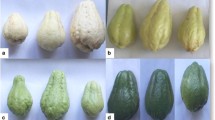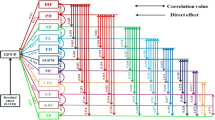Abstract
The chilli (Capsicum sp.) germplasm found throughout North Eastern (NE) India exhibits wide variability in fruit morphology, pungency, bearing habit and crop duration. As the genetic resources of chilli landraces from this region are not well documented, it is likely that they have hitherto unknown alleles and/or genes for economically important traits. In this study, 53 chilli accessions from different areas of this NE region were evaluated for genetic diversity using various morphological characters and 50 simple sequence repeat markers. It was found that erect and campanulate fruit types are grouped in separate clusters. The number of alleles per locus ranged from 3 to 9 with an average of 5.36. The average polymorphic information content value was 0.52. Percentage variation among populations, within individuals of population and within individuals was found to be 34, 57.9 and 8.05 %, respectively, indicating diversity in the landraces sampled. Allele mining across acyltransferase 3 (AT3) gene in a set of landraces led to identification of new single nucleotide polymorphisms (SNPs). Sequence analysis of the 2,349 bp AT3 region revealed the presence of a total of 79 SNPs and 3 indels. This overview of diversity of chilli landraces from NE India paves the way for conservation and utilisation of germplasm and contributes to the development of systematic breeding strategies.




Similar content being viewed by others
References
Adetula O (2006) Genetic diversity of Capsicum using random amplified polymorphic DNAs. Afr J Biotech 5:120–122
Aktas H, Abak K, Sensoy S (2009) Genetic diversity in some Turkish pepper (Capsicum annuum L.) genotypes revealed by AFLP analyses. Afr J Biotech 8:4378–4386
Aluru MR, Mazourek M, Landry LG, Curry J, Jahn M, O’Connell MA (2003) Differential expression of fatty acid synthase genes, Acl, Fat and Kas, in Capsicum fruit. J Exp Botany 54:1655–1664
Asati BS, Yadav DS (2004) Diversity of horticultural crops in north eastern region. ENVIS Bull Himal Ecol 12:1–11
Barerra LQ, Garcia MC, Giraldo MC, Melgarejo LM (2005) Isozyme characterization of Capsicum accessions from the Amazonian Colombia collection. Revista Colombiana de Biotechnologia 7:59–65
Basu SK, De AK (2003) Capsicum: historical and botanical perspectives. In: De AK (ed) The genus Capsicum. Taylor & Francis, London, pp 1–15
Bhagowati RR, Changkija S (2009) Genetic variability and traditional practices in Naga king chilli landraces of Nagaland. Asian Agri-Hist 13:171–180
Board S (2004) Spice Statistics. Spice Board Cochin, Kerala, p 281
Borgohain R, Devi J, Samar N (2005) Intra- and interspecific genetic diversity exploration in chilli (Capsicum spp.) using morphological and randomly applied polymorphic DNA markers. Indian J Agri Sci 75:582–585
Bosland PW, Baral JB (2007) ‘Bhut Jolokia’—the world’s hottest known chile pepper is a putative naturally occurring interspecific hybrid. Hort Sci 42:222–224
Botstein D, White RL, Skolnick M, Davis RW (1980) Construction of a genetic linkage map in man using restriction fragment length polymorphisms. Am J Hum Genet 32:314–333
Cavalli-Sforza LL, Edwards AWF (1967) Phylogenetic analysis: models and estimation procedures. Evolution 21:550–570
Dhaliwal MS (2007) Solanaceous vegetables. In: Handbook of vegetable crops. Kalyani Publishers, Ludhiana, India
Geleta LF, Labuschagne MT, Viljoen CD (2005) Genetic variability in pepper (Capsicum annuum L.) estimated by morphological data and amplified fragment length polymorphism markers. Biodivers Conserv 14:2361–2375
Gogoi D, Gautam BP (2002) Variability, heritability and genetic advance in chilli (Capsicum spp.). Agric Sci Dig 22:102–104
Guinness Book of World Records (2006) Hottest spice. http://www.guinnessworldrecords.com
Guzman FA, Ayala H, Azurdia C, Duque MC, de Vicen MC (2005) AFLP assessment of genetic diversity of Capsicum genetic resources in Guatemala: home gardens as an option for conservation. Crop Sci 45:363–370
Hall TA (1999) BioEdit: a user-friendly biological sequence alignment editor and analysis program for Windows 95/98/NT. Nucleic Acids Symp Ser 41:95–98
Hanacek P, Vyhnanek T, Rohrer M, Cieslarova J, Stavelíkova H (2009) DNA polymorphism in genetic resources of red pepper using microsatellite markers. Hort Sci (Prague) 36:127–132
Huff DR, Peakall R, Smouse PE (1993) RAPD variation within and among populations of outcrossing buffalograss (Buchloe dactyloides (Nutt.) Engelm). Theor Appl Genet 86:927–934
Ince AG, Karaca M, Onus AN (2009) Development and utilization of diagnostic DAMD-PCR markers for Capsicum accessions. Genet Resour Crop Evol 56:211–221
Ince AG, Karaca M, Onus AN (2010a) CAPS-microsatellites: use of CAPS method to convert non-polymorphic microsatellites into useful markers. Mol Breed 25:491–499
Ince AG, Karaca M, Onus AN (2010b) Polymorphic microsatellite markers transferable across Capsicum species. Plant Mol Bio Rep 28:285–291
Indian Horticulture Database (2011) National Horticulture Board. Aristo Printing Press, New Delhi, pp 6–7
International Board for Plant Genetic Resources (IBPGR) (1983) Genetic resources of Capsicum, a global plan and action. Rome. 8–10
Jung J, Park SW, Liu WY, Kang BC (2010) Discovery of single nucleotide polymorphism in Capsicum and SNP markers for cultivar identification. Euphytica 175:91–107
Kang BC, Nahm SH, Huh JH, Yoo HS, Yu JW (2001) An interspecific (Capsicum annuum × C. chinese) F2 linkage map in pepper using RFLP and AFLP markers. Theor Appl Genet 102:531–539
Kochieva EZ, Ryzhova NN (2003) Molecular AFLP analysis of the genotypes of pepper Capsicum annuum cultivars. Russ J Genet 39:1345–1348
Kwon YS, Lee JM, Yi GB, Yi SI, Kim KM, Soh EH, Bae KM, Park EK, Song IH, Kim BD (2005) Use of SSR markers to complement tests of distinctiveness, uniformity, and stability (DUS) of pepper (Capsicum annuum L.) varieties. Mol Cells 19:428–435
Lang Y, Yanagawa S, Sasanuma T, Sasakuma T (2006) A gene encoding a putative acyl-transferase involved in pungency of Capsicum. Breed Sci 56:55–62
Lee JM, Nahm SH, Kim YM, Kim BD (2004) Characterization and molecular genetic mapping of microsatellite loci in pepper. Theor Appl Genet 108:619–627
Mantel N (1967) The detection of disease clustering and a generalized regression approach. Cancer Res 27:209–220
Minamiyama Y, Tsuro M, Hirai M (2006) An SSR-based linkage map of Capsicum annuum. Mol Breed 18:157–169
Murray MG, Thompson WF (1980) Rapid isolation of high molecular weight plant DNA. Nucleic Acid Res 8:4321–4325
Paran I, Aftergoot E, Shifriss C (1998) Variation in Capsicum annuum revealed by RAPD and AFLP markers. Euphytica 99:167–173
Patel AS, Sasidharan N, Vala AG, Kumar V (2011) Genetic relation in Capsicum annum [L.] cultivars through microsatellite markers: SSR and ISSR. J Plant Breed 2:67–76
Pickersgill B, Heiser CB, McNeill J (1979) Numerical taxonomic studies on variation and domestication in some species of Capsicum. In: Hawkes JG, Lester RN, Skelding AD (eds) The biology and taxonomy of Solanaceae. Linnean Society Symposium 7. Academic, London, pp 678–700
Prasad BCN, Kumar V, Gururaj HB, Parimalan R, Giridhar P, Ravishankar GA (2006) Characterization of capsaicin synthase and identification of its gene (csy1) for pungency factor capsaicin in pepper (Capsicum sp.). PNAS 103:13315–13320
Rafalski A (2002) Applications of single nucleotide polymorphisms in crop genetics. Curr Opin Plant Biol 5:94–100
Rodrigues KF, Tam HK (2010) Molecular markers for Capsicum frutescens varieties cultivated in Borneo. J Plant Breed Crop Sci 2:165–167
Rossetto M, Weaver PK, Dixon KW (1995) Use of RAPD analysis in devising conservation strategies for the rare and endangered Grevillea scapigera (Proteaceae). Mol Ecol 4:321–329
Sanatombi K, Sen-Mandi S, Sharma GJ (2010) DNA profiling of Capsicum landraces of Manipur. Sci Hortic 124:405–408
Sitthiwong K, Matsui T, Sukprakarn S, Okuda N, Kosugi Y (2005) Classification of pepper (Capsicum annum L.) accessions by RAPD analysis. Biotechnology 4:305–309
Stewart C, Kang BC, Liu K, Mazourek M, Moore SL, Yoo EY, Kim BD, Paran I, Jahn MM (2005) The Pun1 gene for pungency in pepper encodes a putative acyltransferase. Plant J 42:675–688
Thresh JC (1876) Isolation of capsaicin. The Pharmaceutical Journal and Transactions 6:941–947
Thul ST, Lal RK, Shasany AK, Darokar MP, Gupta AK, Gupta MM, Verma RK, Khanuja SPS (2009) Estimation of phenotypic divergence in a collection of Capsicum species for yield-related traits. Euphytica 168:189–196
Toquica SP, Rodriguez F, Martinez E, Duque MC, Tohme J (2003) Molecular characterization by AFLPs of Capsicum germplasm from the Amazon Department in Colombia. Genet Resour Crop Evol 50:639–647
Tsaballa A, Pasentsis K, Tsaftaris AS (2011a) Τhe role of a gibberellin 20-oxidase gene in fruit development in pepper (Capsicum annuum). Plant Mol Biol Rep. doi:10.1007/s11105-011-0364-8
Tsaballa A, Pasentsis K, Darzentas N, Tsaftaris A (2011b) Multiple evidence for the role of an ovate-like gene in determining fruit shape in pepper. BMC Plant Biol 11:46
Yi G, Lee JM, Lee S, Choi D, Kim BD (2006) Exploitation of pepper EST–SSRs and an SSR-based linkage map. Theor Appl Genet 114:113–130
Yu JK, Paik H, Choi JP, Han J-H, Choe JK, Hur CG (2010) Functional domain marker (FDM): an in silico demonstration in Solanaceae using simple sequence repeats (SSRs). Plant Mol Biol Rep 28:352–356
Acknowledgments
This work was supported in part by the Intramural Research Project (IRP), Central Agricultural University (CAU), Imphal, India to WT. JSY was supported by a student fellowship from CAU. The authors would like to thank Dr. V.K. Khanna for sharing the seeds of ‘type species’ of Capsicum obtained from IVRI, Varanasi. The authors would also like to thank M.Sc. students of CPGS who helped in collecting landraces from different districts of NE India.
Author information
Authors and Affiliations
Corresponding author
Electronic supplementary material
Below is the link to the electronic supplementary material.
Supplementary Table 1
List of chilli genotypes with geographical distribution used in the current study (XLS 22 kb)
Supplementary Table 2
List of edited morphological descriptors used in the current study (XLS 25 kb)
Rights and permissions
About this article
Cite this article
Yumnam, J.S., Tyagi, W., Pandey, A. et al. Evaluation of Genetic Diversity of Chilli Landraces from North Eastern India Based on Morphology, SSR Markers and the Pun1 Locus. Plant Mol Biol Rep 30, 1470–1479 (2012). https://doi.org/10.1007/s11105-012-0466-y
Published:
Issue Date:
DOI: https://doi.org/10.1007/s11105-012-0466-y




